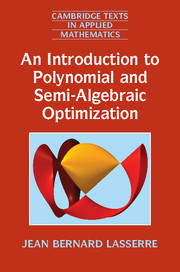Book contents
- Frontmatter
- Dedication
- Contents
- Preface
- List of symbols
- 1 Introduction and message of the book
- PART I POSITIVE POLYNOMIALS AND MOMENT PROBLEMS
- PART II POLYNOMIAL AND SEMI-ALGEBRAIC OPTIMIZATION
- PART III Specializations and extensions
- Appendix A Semidefinite programming
- Appendix B The GloptiPoly software
- References
- Index
- References
References
Published online by Cambridge University Press: 05 February 2015
- Frontmatter
- Dedication
- Contents
- Preface
- List of symbols
- 1 Introduction and message of the book
- PART I POSITIVE POLYNOMIALS AND MOMENT PROBLEMS
- PART II POLYNOMIAL AND SEMI-ALGEBRAIC OPTIMIZATION
- PART III Specializations and extensions
- Appendix A Semidefinite programming
- Appendix B The GloptiPoly software
- References
- Index
- References
- Type
- Chapter
- Information
- An Introduction to Polynomial and Semi-Algebraic Optimization , pp. 324 - 336Publisher: Cambridge University PressPrint publication year: 2015

